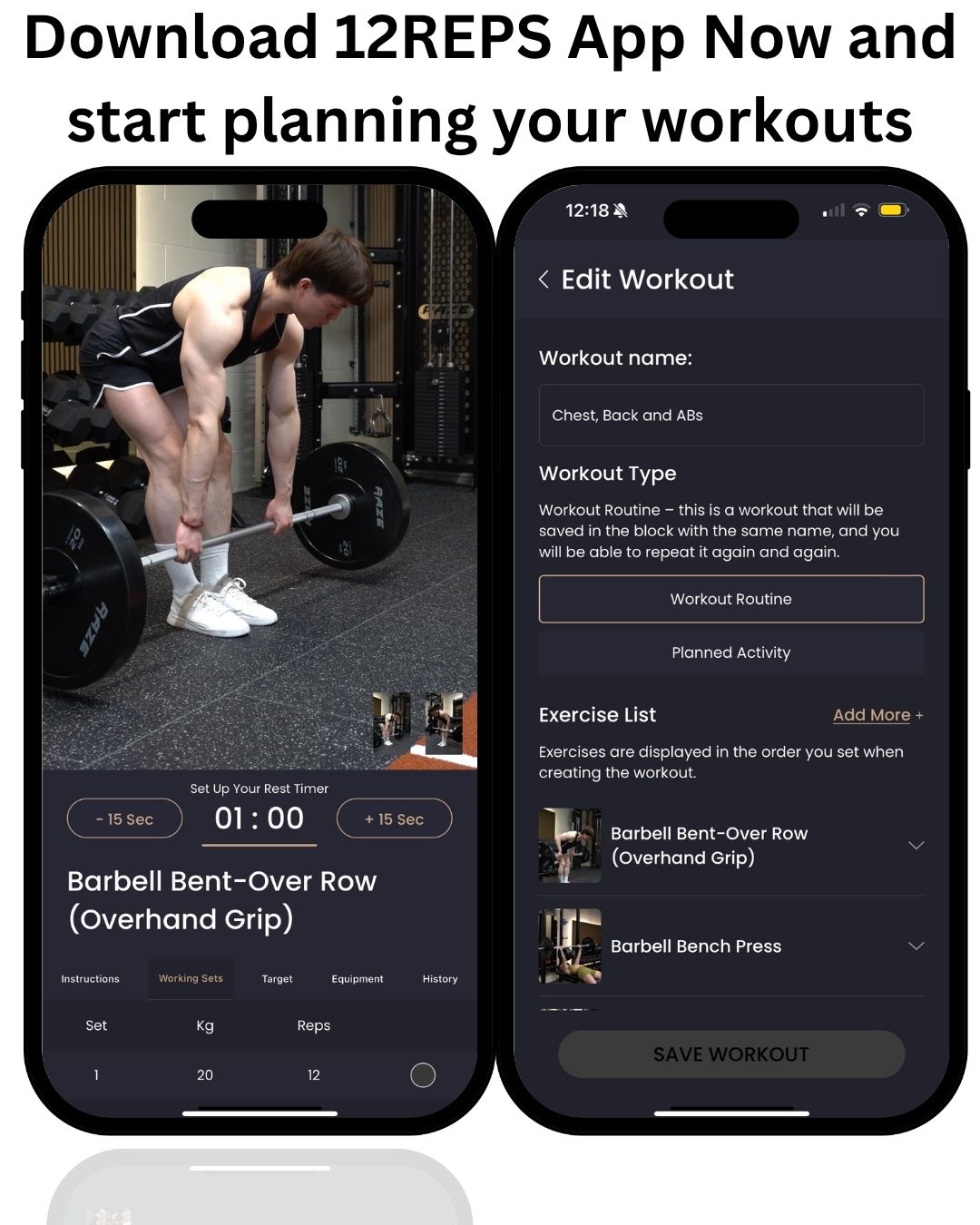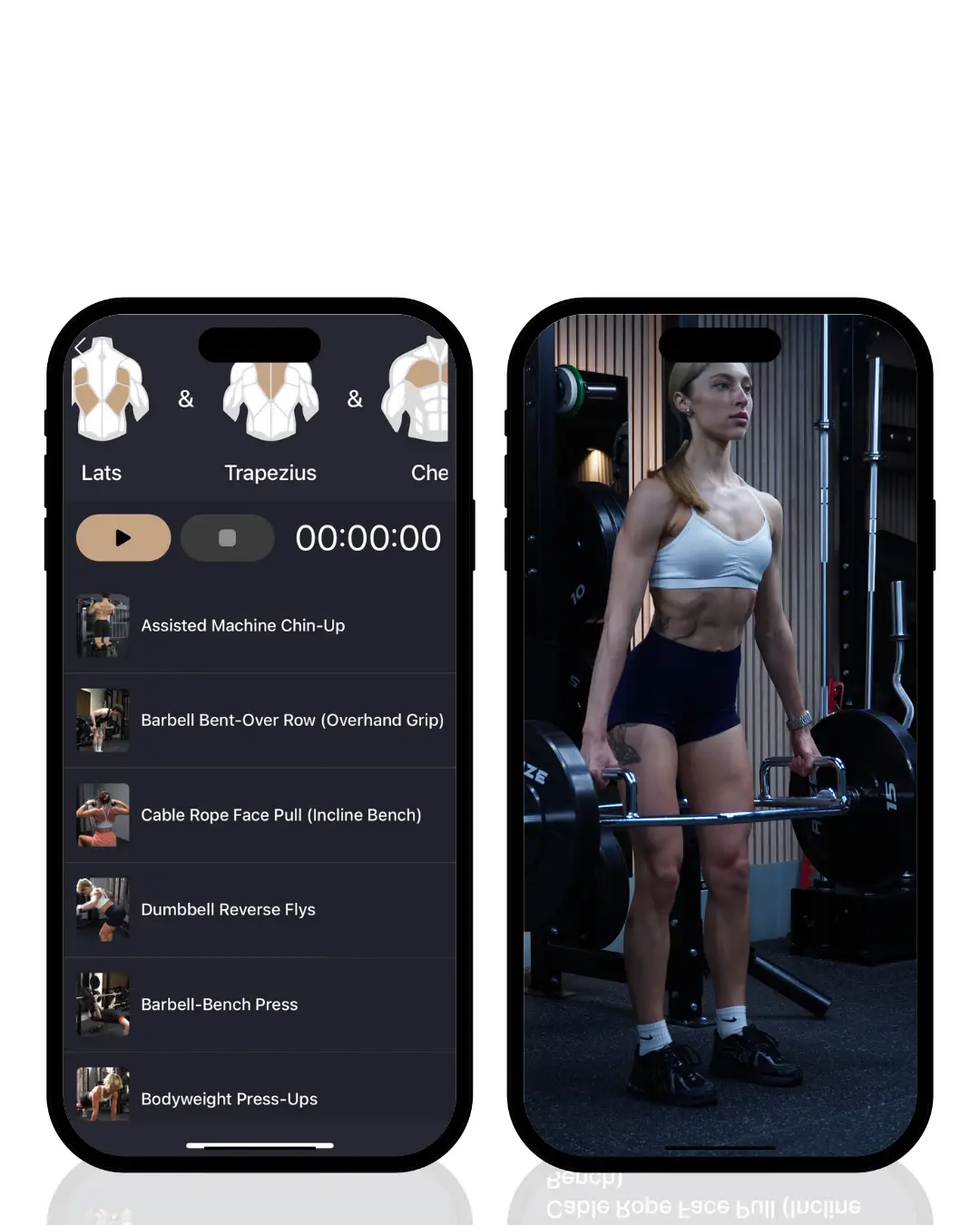By Will Duru, BSc (Hons) Sport and Exercise Science, Award-winning Personal Trainer with over 10 years of experience in strength training and optimising recovery.
You don’t need 2-hour gym sessions to build muscle. After training busy professionals for over a decade, I’ve proven that 45 minutes, 3-4 times per week, delivers better results than marathon workouts. The fitness industry perpetuates the myth that more equals better, but science tells a different story.
Research consistently shows you can achieve remarkable muscle growth with a fraction of the time investment most people believe necessary. Your muscles respond to stimulus quality, not duration. When you understand the minimum effective dose for muscle growth, you can trigger the same adaptive response in 45 minutes that others chase for hours.
This isn’t about shortcuts or compromising results. It’s about applying proven science efficiently. The principles covered here form the foundation of time-efficient muscle building, whether you have 30 minutes or an hour available.
The 12Reps app is designed for busy people who want maximum results in minimum time. These evidence-based principles ensure every minute of your workout counts, fitting seamlessly into your packed schedule without sacrificing the life you’ve built.

Section 1: The Science of Training Efficiency
Understanding Minimum Effective Dose
The minimum effective dose (MED) concept revolutionises muscle building. Borrowed from pharmacology, MED represents the smallest stimulus needed to produce desired outcomes. In muscle building, this translates to the least training required to trigger meaningful growth.
Recent research has fundamentally shifted our understanding of training volume requirements. A comprehensive study published in Sports Medicine found that as little as 4 sets per muscle group per week produces significant muscle growth [1]. This challenges decades of conventional wisdom suggesting much higher volumes were necessary.
When researchers compared groups performing 4, 8, and 16 sets per muscle group weekly, the 4-set group achieved approximately 85% of the muscle growth seen in the highest volume group – in a fraction of the time. This isn’t just academic theory; it’s a practical application for anyone juggling work, family, and fitness goals.
The relationship between training volume and muscle growth follows the law of diminishing returns. Initially, each additional set provides substantial benefit. However, as volume increases, each new set contributes progressively less while demanding increasingly more recovery resources.
High-volume training doesn’t just demand more gym time; it requires exponentially more recovery resources. Sleep needs increase, nutritional demands skyrocket, and stress hormones remain elevated longer. For busy individuals, these hidden costs often sabotage results more than the training itself.
Research shows training beyond optimal volumes can actually impair muscle growth. Excessive training elevates cortisol levels, directly interfering with protein synthesis, the process responsible for building muscle. It also depletes glycogen stores faster than they can be replenished, leaving muscles chronically energy-depleted.
Why 12 Reps Maximises Efficiency
The 12-rep range optimises multiple training variables simultaneously. Traditional thinking divided rep ranges into rigid categories: 1-5 for strength, 6-12 for muscle growth, 15+ for endurance. Modern research reveals a more nuanced reality.
While muscle growth occurs across wide rep ranges, the 8-15 range, with 12 sitting perfectly in the middle, offers unique advantages for time-efficient training [2]. At 12 reps, you’re working with approximately 70-75% of your one-rep maximum, creating optimal balance between mechanical tension and metabolic stress.
This load is heavy enough to recruit high-threshold motor units (muscle fibres with the greatest growth potential) while light enough to maintain recruitment throughout the entire set. The time efficiency becomes apparent when considering work-to-rest ratios.
A 12-rep set takes 30-40 seconds with 60-90 seconds rest. This creates favourable ratios where you spend roughly equal time working and recovering, maximising training stimulus per minute. Compare this to powerlifting-style training, where heavy triples take 15 seconds but require 3-5 minutes rest, incredibly time-inefficient for muscle building.
The metabolic demands of 12-rep sets create favourable conditions for muscle growth. This rep range generates significant metabolic stress, leading to the accumulation of metabolites like lactate and hydrogen ions. These serve as powerful signals for muscle adaptation, triggering growth factor release and enhancing protein synthesis.
From a practical standpoint, 12 reps offer psychological advantages. It’s challenging enough to feel productive but not so gruelling that it becomes mentally daunting. This sweet spot helps maintain motivation and consistency, crucial factors for long-term success.

Time-Response Relationships
Understanding how muscles respond to training stimuli reveals why efficient protocols often outperform lengthy ones. Muscle protein synthesis, the process of building new muscle tissue, follows predictable patterns after resistance training.
Following effective workouts, protein synthesis elevates within hours and remains elevated for 24-48 hours in trained individuals. This window represents your muscle-building opportunity. The key insight: this response is triggered by stimulus quality, not duration. Well-designed 45-minute workouts elevate protein synthesis as effectively as 2-hour sessions.
The 12Reps methodology is built on efficiency principles, giving maximum results in 45 minutes or less per workout. When you understand muscle growth occurs during recovery, not training, focus shifts from maximising gym time to optimising stimulus that triggers adaptation.
Research reveals muscle protein synthesis follows dose-response curves with clear ceilings. Once you’ve provided sufficient stimulus to maximally elevate protein synthesis, additional training volume provides no extra benefit. This explains why splitting training across multiple shorter sessions often produces better results than cramming everything into marathon workouts.

Multi-Joint Movement Science
The science behind multi-joint movements reveals their effectiveness for time-efficient muscle building. When multiple joints move simultaneously, the nervous system recruits muscle fibres in coordinated patterns closely mimicking real-world movement demands. This recruitment pattern is more metabolically demanding and creates greater mechanical tension across multiple muscle groups.
Consider the bench press versus chest fly differences. Both target pectoral muscles, but bench press involves movement at the shoulder and elbow joints, requiring coordination between the chest, shoulders, and triceps. This multi-joint involvement means handling heavier loads, creating greater mechanical tension, and stimulating more total muscle mass simultaneously.
Metabolic demands of multi-joint movements contribute to efficiency. These exercises require more energy, leading to greater caloric expenditure during and after workouts. Elevated post-exercise oxygen consumption (EPOC) following compound movements can remain elevated for hours, contributing to improved body composition even when not actively training.
Strategic Exercise Selection
Understanding muscle activation patterns allows selecting exercises providing the greatest stimulus with the least time investment. Electromyography studies reveal which exercises create the highest muscle activation levels across different muscle groups, providing scientific foundations for efficient selection.
For the upper body, research consistently shows pull-ups and chin-ups create higher latissimus dorsi activation than any machine-based alternative. Push-ups and variations often match or exceed muscle activation achieved by bench pressing while requiring no equipment and engaging additional stabilising muscles.
The most effective exercises often aren’t the most complicated. Basic movement patterns, pushing, pulling, squatting, and hip hinging, form efficient training foundations because they align with how your body is designed to move. These patterns allow handling the greatest loads through the fullest ranges of motion, maximising mechanical tension and muscle stretch.
Essential Exercise Categories:
Upper Body Pushing:
– Push-ups (bodyweight, equipment-free)
– Bench press (horizontal pushing)
– Overhead press (vertical pushing, core stability)
Upper Body Pulling:
– Pull-ups/chin-ups (vertical pulling)
– Rows (horizontal pulling)
– Face pulls (posterior deltoid, posture)
Lower Body Knee-Dominant:
– Squats (quads, glutes, core)
– Lunges (unilateral strength, stability)
– Step-ups (functional movement)
Lower Body Hip-Dominant:
– Deadlifts (posterior chain)
– Hip thrusts (glute activation)
– Romanian deadlifts (hamstring emphasis)
The just12reps app prioritises the most efficient exercises, ensuring every minute of your workout counts by focusing on movements that provide maximum muscle activation with minimal time investment.
Time-Saving Exercise Combinations
Advanced strategies can enhance efficiency through exercise combinations, maximising training density without compromising quality. Supersets, circuits, and compound sets accomplish more work in less time while maintaining necessary stimulus for muscle growth.
Supersets involve performing two exercises back-to-back with minimal rest. Most effective supersets for muscle building pair exercises targeting opposing muscle groups or completely different muscle groups. Pairing squats with pull-ups allows legs to recover while the upper body works, maintaining training intensity while reducing total workout time.
Physiological benefits extend beyond time savings. Brief rest periods create favourable metabolic environments for muscle growth, with elevated lactate levels and increased growth hormone release. This metabolic stress complements mechanical tension from exercises themselves, providing a potent stimulus for adaptation.
Circuit training links three or more exercises in sequence. When designed properly, circuits provide effective muscle-building stimulus while simultaneously improving cardiovascular fitness. The key is selecting exercises targeting different movement patterns or muscle groups, allowing each area to recover while others work.
Sample Superset Combinations:
– Squats + Pull-ups (lower/upper body)
– Bench Press + Bent-over Rows (push/pull)
– Overhead Press + Deadlifts (upper/lower body)
– Lunges + Push-ups (legs/chest)
Section 3: Optimal Training Frequency and Duration
Training Frequency Research
The question of training frequency has clear research-backed answers. A landmark meta-analysis examining training frequency and muscle growth found that training each muscle group twice per week produced significantly greater hypertrophy than once-weekly training when total volume was equated [3].
The biological explanation lies in the duration of protein synthesis following resistance training. Muscle protein synthesis remains elevated for 24-48 hours after effective workouts. Training each muscle group only once weekly allows 5-6 days where protein synthesis returns to baseline, missed opportunities for muscle growth.
Consider two scenarios: Person A trains chest once weekly with 12 sets in a single session, while Person B trains chest twice weekly with 6 sets per session. Both perform identical total weekly volume, but Person B experiences two separate protein synthesis elevations, potentially leading to greater overall muscle growth.
This principle has profound implications for busy individuals. Rather than cramming all training into one or two marathon sessions, you achieve better results by distributing the same work across more frequent, shorter sessions. This approach improves muscle-building outcomes while making individual workouts more manageable and sustainable.
Optimal Workout Duration
The relationship between workout duration and muscle-building effectiveness follows clear patterns. There’s a point of diminishing returns where longer sessions provide minimal additional benefit while significantly increasing fatigue and recovery demands.
Research suggests optimal workout duration falls between 30-60 minutes, with 45 minutes emerging as the sweet spot for most individuals. This duration allows sufficient time to perform 12-16 total sets across multiple muscle groups while maintaining high intensity throughout sessions.
Physiological rationale relates to hormonal responses and energy system demands. Workouts lasting longer than 60-75 minutes often lead to elevated cortisol levels, interfering with muscle protein synthesis and recovery. Additionally, muscle glycogen stores become depleted during extended sessions, reducing the quality of subsequent exercise and potentially compromising training stimulus.
Duration Guidelines:
– 30 minutes: 3 exercises, 2-3 sets each
– 45 minutes: 4-5 exercises, 3 sets each
– 60 minutes: 5-6 exercises, 3-4 sets each
Frequency vs. Life Demands
Theoretical optimal training frequency means nothing if it doesn’t align with real-world constraints. The key to sustainable muscle building is finding the highest frequency you can maintain consistently, given work schedules, family obligations, and other life demands.
For many busy professionals, traditional Monday-Wednesday-Friday schedules work well because they provide consistent spacing between sessions while leaving weekends free. However, this schedule isn’t mandatory; what matters is achieving the target frequency over each week, regardless of specific days chosen.
Some individuals find success with Monday-Tuesday, Thursday-Friday approaches, training on consecutive days twice weekly. While this creates uneven spacing between sessions, it can work well for those with demanding mid-week schedules or weekend family commitments.
Flexible Scheduling Options:
– 3-day: Mon/Wed/Fri or Tue/Thu/Sat
– 4-day: Mon/Tue, Thu/Fri or Mon/Thu, Tue/Fri
– Variable: Adjust based on weekly demands
Creating Sustainable Schedules
Sustainability determines training success. The most scientifically optimal program is worthless if you can’t maintain it consistently over months and years. Creating sustainable schedules requires an honest assessment of your lifestyle and building training around your reality.
Start by identifying your most consistent available time slots. For many people, early morning training provides the greatest consistency because it occurs before daily demands can interfere. Others find lunch-time sessions work well, while some prefer evening training as stress relief.
Consider your energy patterns throughout the day. If you’re naturally energetic in the morning, that might be optimal training time even if it requires waking earlier. Conversely, if you’re not a morning person, forcing early workouts might lead to poor adherence and suboptimal performance.
Build buffer time into schedules. If you have exactly 45 minutes available, plan for 40-minute workouts to account for unexpected delays or longer warm-ups. This buffer prevents the stress of rushing through workouts or skipping sessions when things don’t go exactly as planned.
Section 4: Recovery Optimisation for Busy People
Sleep Optimisation
Sleep represents the most powerful recovery tool available, yet it’s often the first sacrifice when life gets busy. This is particularly counterproductive for muscle building, as the majority of growth hormone release occurs during deep sleep phases.
The relationship between sleep and muscle building operates through multiple pathways. During deep sleep, your body releases growth hormone in pulsatile bursts, with the largest releases occurring during the first few hours. This hormone directly stimulates muscle protein synthesis and helps mobilise fat for energy.
Sleep deprivation elevates cortisol levels, directly interfering with muscle protein synthesis while promoting muscle breakdown. Even single nights of poor sleep can reduce protein synthesis rates by up to 20%, effectively negating much stimulus from previous workouts.
Sleep Optimisation Strategies:
– Maintain consistent sleep/wake times
– Keep bedroom cool (65-68°F)
– Minimise light exposure in the evening
– Avoid screens 30 minutes before bed
– Consider 20-30 minute afternoon naps if needed
While eight hours might be ideal, consistently achieving 6-7 hours of quality sleep is more valuable than getting eight hours sporadically. Focus on sleep consistency over perfect duration.
Nutrition Timing
Nutrition timing can significantly impact recovery and muscle building without requiring complex meal planning or constant food preparation. Understanding key principles allows optimising nutrition timing within existing eating patterns.
The post-workout nutrition window is real but more forgiving than often portrayed. While consuming protein within 2-3 hours after training is beneficial, dramatic urgency often portrayed in fitness media is overblown. This flexibility means planning training around existing meal schedules rather than restructuring entire days around workout nutrition.
Protein distribution throughout the day appears more important than precise timing around workouts. Consuming 20-30 grams of high-quality protein every 3-4 hours provides a steady amino acid supply for muscle protein synthesis. This can be achieved through regular meals without requiring special supplements or complicated timing protocols.
Practical Nutrition Timing:
– Pre-workout: Light meal/snack 1-2 hours before training
– Post-workout: Protein-rich meal within 2-3 hours
– Daily: 20-30g protein every 3-4 hours
– Hydration: Consistent throughout day, not just around workouts
Stress Management
Chronic stress is perhaps the greatest enemy of muscle building for busy individuals. Elevated cortisol levels from work pressure, family responsibilities, and time constraints can completely override muscle-building stimulus from even well-designed training programs.
The physiological impact of chronic stress operates through multiple mechanisms. Elevated cortisol directly inhibits muscle protein synthesis while promoting muscle protein breakdown. Chronic stress also impairs sleep quality, reduces appetite for protein-rich foods, and decreases motivation for consistent training.
Efficient Stress Management:
– Deep breathing exercises (5 minutes anywhere)
– Use training as stress relief, not an additional stressor
– Prepare workout clothes the night before
– Set realistic expectations for training consistency
– Practice mindfulness during existing activities
Physical activity itself serves as a powerful stress management tool, creating positive feedback loops where training builds muscle while enhancing the ability to handle life stress. The key is ensuring training serves as stress relief rather than an additional stressor.
Recovery Between Sessions
The time between training sessions represents crucial windows for adaptation. Optimising this period can significantly enhance results without requiring additional training time. Understanding how to maximise recovery between sessions allows for more frequent and intense training.
Active recovery between sessions involves light movement promoting circulation without adding significant stress. This might include walking meetings, taking stairs instead of elevators, or light stretching while watching television. These activities enhance blood flow to recovering muscles while fitting naturally into daily routines.
Recovery Enhancement Strategies:
– Light movement on rest days
– Adequate spacing between sessions (24+ hours)
– Contrast showers (hot/cold alternating)
– Monitor recovery indicators (sleep quality, energy levels)
– Adjust training intensity based on recovery status

Section 5: Sample Efficient 12-Rep Programs
3-Day Full-Body Foundation
The three-day full-body routine represents the gold standard for time-efficient muscle building. This approach trains every muscle group three times per week while keeping individual sessions manageable and sustainable.
Day 1: Monday (Full Body)
– Squats: 3 sets x 12 reps (90 seconds rest)
– Push-ups/Bench Press: 3 sets x 12 reps (90 seconds rest)
– Bent-over Rows: 3 sets x 12 reps (90 seconds rest)
– Plank: 2 sets x 30-60 seconds (60 seconds rest)
– Calf Raises: 2 sets x 15 reps (60 seconds rest)
Day 2: Wednesday (Full Body)
– Deadlifts: 3 sets x 12 reps (90 seconds rest)
– Overhead Press: 3 sets x 12 reps (90 seconds rest)
– Pull-ups/Lat Pulldowns: 3 sets x 12 reps (90 seconds rest)
– Lunges: 2 sets x 12 per leg (60 seconds rest)
– Bicycle Crunches: 2 sets x 20 total (60 seconds rest)
Day 3: Friday (Full Body)
– Goblet Squats: 3 sets x 12 reps (90 seconds rest)
– Incline Push-ups/Press: 3 sets x 12 reps (90 seconds rest)
– Single-arm Rows: 3 sets x 12 per arm (90 seconds rest)
– Step-ups: 2 sets x 12 per leg (60 seconds rest)
– Russian Twists: 2 sets x 20 total (60 seconds rest)
Each session takes 35-45 minutes, including warm-up and cool-down. This routine provides 9 sets per muscle group weekly – well above the minimum effective dose.
4-Day Upper/Lower Split
For those who can commit to four training sessions weekly, the upper/lower split provides additional volume while maintaining manageable session lengths. This approach allows greater specialisation while still training each muscle group twice weekly.
Upper Body Days (Monday/Thursday)
– Pull-ups/Lat Pulldowns: 3 sets x 12 reps
– Bench Press/Push-ups: 3 sets x 12 reps
– Bent-over Rows: 3 sets x 12 reps
– Overhead Press: 3 sets x 12 reps
– Bicep Curls: 2 sets x 12 reps
– Tricep Extensions: 2 sets x 12 reps
Lower Body Days (Tuesday/Friday)
– Squats: 4 sets x 12 reps
– Deadlifts: 3 sets x 12 reps
– Lunges: 3 sets x 12 per leg
– Calf Raises: 3 sets x 15 reps
– Plank: 2 sets x 45 seconds
– Glute Bridges: 2 sets x 15 reps
This split allows for greater volume per muscle group while maintaining twice-weekly frequency. Each session takes 45-55 minutes.
Progression Strategies
Progressive overload, gradually increasing demands placed on muscles, is essential for continued growth. Simple, sustainable progression strategies work best for time-constrained individuals who need consistency over complexity.
Linear Progression:
Add 2.5-5 pounds when you complete all prescribed reps with perfect form. If you can perform 3 sets of 12 reps with the given weight, increase the load for the next session.
Rep Progression:
When adding weight isn’t possible, increase the number of reps with the same weight. Progress from 12 to 13, then 14, then 15 before returning to 12 reps with increased weight.
Density Progression:
Perform the same work in less time by reducing rest periods from 90 seconds to 75 seconds, or completing entire workouts faster.
Quality Progression:
Improve movement execution through increased range of motion, better control during lowering phases, or adding pauses at challenging positions.
These proven programs are built into the 12reps app, with flexible scheduling to fit your busy lifestyle. The app automatically adapts training based on available time and equipment, ensuring consistency regardless of changing circumstances.

Conclusion
Efficient muscle building is not only possible, it’s superior to time-wasting approaches. Research proves that 4+ sets per muscle group weekly, using compound movements in the 8-15 rep range, 2-3 times per week, produces excellent results in minimal time.
The 12-rep sweet spot optimises mechanical tension and metabolic stress while maintaining time efficiency. Compound movements maximise muscle activation per minute invested. Recovery happens outside the gym through quality sleep, proper nutrition timing, and stress management.
Your busy schedule isn’t an obstacle to muscle building, it’s an advantage that forces focus on what actually works. The most effective exercises, optimal rep ranges, and proven frequencies all support time-efficient training that fits into real life.
The minimum effective dose principle isn’t about cutting corners; it’s about understanding that muscles respond to stimulus quality, not duration. When you provide adequate stimulus through proven methods, your body will adapt and grow regardless of whether you spend 45 minutes or 2 hours in the gym.
The transformation begins with a single decision: to stop wasting time with inefficient workouts and start applying science-based principles that deliver results. This doesn’t require a complete life overhaul or massive time commitment – just the willingness to train smarter, not longer.
Stop wasting time with inefficient workouts. Download the 12reps app and build muscle in just 45 minutes, 3-4 times per week. Your future self will thank you for making the choice to train intelligently.
References
[1] Iversen, V. M., Norum, M., Schoenfeld, B. J., & Fimland, M. S. (2021). No Time to Lift? Designing Time-Efficient Training Programs for Strength and Hypertrophy: A Narrative Review. *Sports Medicine*, 51(10), 2079-2095. https://pmc.ncbi.nlm.nih.gov/articles/PMC8449772/
[2] Nuckols, G. (2015). The “Hypertrophy Rep Range” – Fact or Fiction? *Stronger by Science*. https://www.strongerbyscience.com/hypertrophy-range-fact-fiction/
[3] Schoenfeld, B. J., Grgic, J., & Krieger, J. (2019). How many times per week should a muscle be trained to maximize muscle hypertrophy? A systematic review and meta-analysis of studies examining the effects of resistance training frequency. *Journal of Sports Sciences*, 37(11), 1286-1295. https://www.tandfonline.com/doi/abs/10.1080/02640414.2018.1555906
[4] Schoenfeld, B. J., Ogborn, D., & Krieger, J. W. (2016). Effects of Resistance Training Frequency on Measures of Muscle Hypertrophy: A Systematic Review and Meta-Analysis. *Sports Medicine*, 46(11), 1689-1697. https://www.tandfonline.com/doi/abs/10.1080/02640414.2016.1210197









